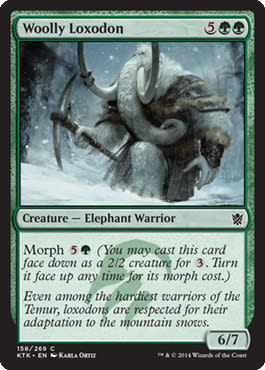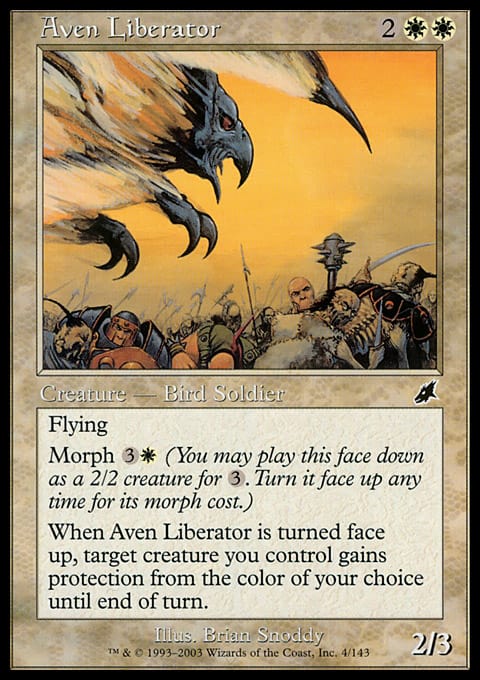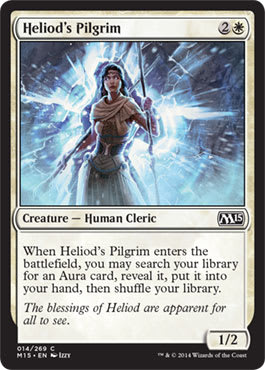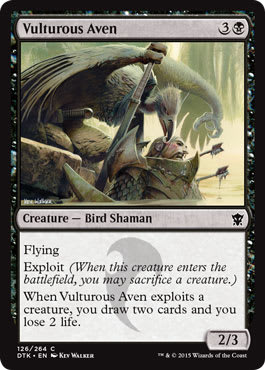In an alternate timeline, I spent a good deal of space talking about why I was not going to be adding any new creatures with morph to my Cube. The main culprit was that none of the creatures featuring the obfuscating ability from Khans of Tarkir met the baseline two-for-one status of existing morphs. The lone creature I had considered was Woolly Loxodon, which garnered my attention because of the invisible keyword big, which acted as a form of card advantage. An accomplice to this issue was saturation: Morphs works better with other morphs. With eight morph creatures in my Cube making a scant 0.02% of the overall composition, a drafter is likely to see one creature that can be played face down every three packs.
To compare, Khans of Tarkir has a morph ASFAN (as the cards of a pack are fanned out) of 2.15, and Dragons of Tarkir has a megamorph ASFAN of 1.64. A big thank you goes out to Matthew Watkins, Limited analyst extraordinaire, for these numbers. In order to approach these numbers, my Cube would have to undergo a rather drastic change.
Why spend the time to talk about this? The reason is that many of the cards I am excited about adding to my Cube from Dragons of Tarkir have megamorph. In order to make morph matter in a manner similar to the various Tarkir Draft formats, I would need to increase the ASFAN of morph in my Cube to at least 1.5 from its current .3. This means going from eight morphs to forty, or nearly 10% of the overall volume of the Cube.
This increase would alter the entire texture of the gameplay experience. In the early days of my stack, I leaned hard on cards like Battering Craghorn and Daru Lancer, which, coincidentally, violate the 5-mana rule instituted for Khans of Tarkir. These cards allowed the aggressive decks present to hit drops consistently but also have mana sinks. Eventually, the Cube became faster, and creatures became better, which squeezed out these combat-only morphs. A Cube that wanted to focus on face-down creatures is one that cares about hidden information and combat tricks. Cards that have often found themselves just off of my list—Ajani's Presence comes to mind—jump up the playable list for their ability to wreak havoc in protracted battles between 2/2 creatures.
I am not going to be taking that route. While it would be an interesting experiment to load up on the best creatures that could be played face down, that is not the experience I want to encourage. I do not want games to evolve into standoffs between clay spiders and balls of draconic energy. More than that, taking this route with the Cube makes it so that the ability to be played face down matters more than the inherent power of the cards. This is bittersweet for me since I absolutely love the way morph plays when a format has an abundance of said creatures, but the fit just is not there.
Rather, I am going to focus on the inclusion of megamorphs that fall largely into the other category: the two-for-one. There is going to be one exception, however, and that will be discussed later. Megamorphs have a lower threshold to achieve than regular morphs since they come with a built-in when-this-is-turned-face-up ability of gaining a +1/+1 counter. Compare this ability to that of one of my favorite morphs in Aven Liberator. Both will let you win a combat or counter certain removal spells, but megamorph leaves a permanent bonus around.
Let’s look at Ojutai Interceptor. This card is not going to be making my Cube, but it bears more than a passing resemblance to Mistform Seaswift—a long time staple. With minimal tribal synergies, the Interceptor has the ability to be a larger threat (for an increased cost). If Seaswift remained in the Cube, it would lose its seat to Ojutai Interceptor—megamorph, regardless of cost, lets creatures matter later into games. As creatures already have an uphill battle against the spells in my Cube, increasing their power does not seem like a bad thing.

So while I am increasing the ASFAN of mega/morph in my Cube from 0.3 to 0.4, it still is nowhere near the most recent Draft environments. Morph is a tool in my Cube to help fix mana and spend it more effectively. It is not going to be a full-on guessing game—with only twelve such creatures, it will be easy enough to suss out what’s hiding under the overlay.
Here are my changes:
Dragons of Tarkir Update
Here’s what I was thinking.
White is going to have two small changes in this update. Totem-Guide Hartebeest has long been a staple of this list and provides white with some much-needed card advantage. The so-called Murder Beest also allows for huge tempo swings and functions as a solid mana sink. It makes sense, then, that the smaller Heliod's Pilgrim should have a shot as well. The exclusion of the Magic 2015 common for this long is more an oversight and a resistance to redundant effects, but it’s time for the Pilgrim to find its home. Sandcrafter Mage has an excellent rate. Normally found in green, the 3/3 for 3 is a powerhouse than can alter the nature of the game if left unchecked. The fact that Sandcrafter Mage can give a point of its power to another creature at haste speed makes it an attractive inclusion and reminds me of Akrasan Squire in many ways. Considering that the G/W color pair has some +1/+1-counter synergies makes this member of the Dromoka clan an easy addition.
Losing their spots are Observant Alseid and Wingsteed Rider. Observant Alseid is a fine card but it does not do enough. As a creature and Aura, it is simply a touch too expensive. Vigilance is strong, but the novelty of bestow is wearing off, and it is time for slightly better mana sinks to enter the fray. Nimbus Naiad and Cavern Lampad are going to retain their slots due to evasion, and Leafcrown Dryad will because of its solid stats and desire for green to have reach. Wingsteed Rider, on the other hand, just never worked out. Heroic, like morph, needs a saturation to be effective. The underperformance of Wingsteed Rider instilled in me a new appreciation of how strong Wizards is at the art of crafting a Limited environment.
Four blue cards are having their shots. Jeskai Sage steps in for Alchemist's Apprentice. The Sage is a fine card that can go on offense and works very well with some of the new black cards. Jeskai Sage also allows me to see how prowess and similar effects will work in my Cube without having to do a rebuild-fueled playtest. I have heard stories of people seeding a Kiln Fiend deck, and the Sage lets me dip my toe in that pool.
Monastery Loremaster is an interesting card. Blue loves its spells, and the ability to gain one back while adding a 4/3 to the board provides so much play to the games in which it hits the board. I love the sheer number of options and opportunities this Djinn provides. Omenspeaker was a nice body, but it does not do nearly as much as Monastery Loremaster while only being a turn faster. Speaking of Djinns, Ojutai's Summons has a chance as 4 power of flyers over two bodies. Cloaked Siren never quite found a home, and in this case, I see the increase in card quality as a true upgrade. Finally, Zephyr Scribe takes the spot of Scroll Thief. Scroll Thief is my fetch, as I keep trying to make it happen. It hasn’t worked yet, and Zephyr Scribe seems to be an engine unto itself rather one that requires an empty board. It also has a prowess-like ability that allows me to test the Kiln Fiend hypothesis.
Black makes like Silumgar in this update and gets fat. First up is Gurmag Angler. I’ve alluded to the invisible keyword of big (thanks, Jon Loucks) before, and Gurmag Angler has the chance to be the biggest big to ever big for almost no cost. I have been consistently impressed with this creature’s ability to just outclass a board in Constructed Pauper, and I am eager to see how its body functions in my Cube. Considering how often creatures trade, I am not going to be surprised if I see this come down as early as turn four. Losing its spot is Sultai Scavenger, which never did much of anything.
Vulturous Aven is a hell of a Magical card. As a 2/3 flyer for
Red is receiving a pretty significant overhaul this update. Red has long been a problem in my Cube because, until recently, it has mechanically been all about quick creatures and burn. My push toward defined archetypes in the past two years also has not helped red. In this update, I walk back some of my experiments. Atarka Efreet is some amazing combination of Skirk Marauder and Blisterstick Shaman, except it comes with 6 power. Six. Combine this with the ability to pick off utility creatures or help take down something in combat, and we have a card that adds an onion’s worth of layers to gameplay. The Efreet is taking the slot of Ember Beast, a pretty bad card, all things considered, that I stuck in because I enjoyed how it played in Boros decks in Gatecrash Limited.
Emrakul's Hatcher is back. Emrakul's Hatcher lost its slot to Pouncing Kavu in an effort to push red’s attacking theme. I felt the Hatcher was too defensive. Even if that is the case, I have been searching for ways to make R/W the “go-wide” combination, and the Hatcher does that while also finding a home in other archetypes. Emrakul's Hatcher was an all-star, and I relegated it to the bench for all the wrong reasons. Forgive me.
Rouse the Mob was another failed experiment. I had hoped that strive and trample would be enough to make an impact. I was wrong. Rouse the Mob is losing its roster spot to Dynacharge, which does a much better job of being an Overrun.
On to green, Cloudcrown Oak was a fixture of my Cube. Its body did good work and helped to shore up green’s defense against flying creatures while providing a reasonable offensive threat. I cut the Oak last year in an effort to make Thrashing Mossdog work because I have an unnatural love for all things Golgari. This turned out to be a mistake, as the Mossdog just never lived up to expectations. As such, it is being cut for the new Cloudcrown Oak Aerie Bowmasters. The Bowmasters is everything the Oak was and then some thanks to megamorph. The fact that Bowmasters (the previously mentioned exception to the two-for-one rule) does not have any additional ability upon being turned face-up—besides the +1/+1 counter—is a testament to how I felt about Cloudcrown Oak and how much I feel green needs that card. I regret cutting down the tree, but at least it made for some good arrows.
Epic Confrontation and Guardian-Shield Bearer are both solid additions to green’s “spell” suite. Epic Confrontation allows green to diversify its spell suite by adding another fight card while Shield Bearers doubles as a combat trick. Alpine Grizzly never quite worked out with its 2 toughness, and Nyxborn Wolf had similar problems to other expensive bestow creatures, so both find themselves on the outs.
Some other cards I considered for this update include Sprinting Warbrute and Stampeding Elk Herd. These two cards provide powerful top ends in their colors and effects that may be needed. The Warbrute is a mana sink for red decks that often empty their hands while also being able to serve the beats. The Elk Herd, on the other hand, lets a green deck punch through that much faster. I will be watching games unfold to see if these cards earn a spot next update.
Similarly, the addition of exploit has me returning to Tortured Existence. With the advent of powerful spell effects that are triggered by creatures dying, it makes me wonder if now is the time to make headway into a graveyard theme. Adding cards like Gurmag Drowner and Satyr Wayfinder, fine cards on their own, to the Cube along with Tortured Existence would allow both Dimir and Golgari decks to take on another layer of complexity if they were able to draft the Stronghold enchantment. My main hesitancy at this point is the lack of secondary options. Undertaker exists, but I am not sure it is enough.
Here is a copy of my Cube with all of the updates. It is certainly going to be an interesting few weeks until Modern Masters (2015 Edition) comes out. Until then, it’s time to draft.




























